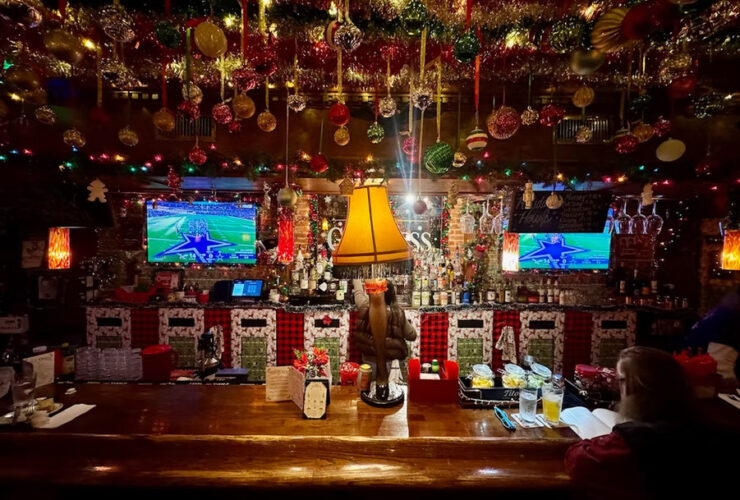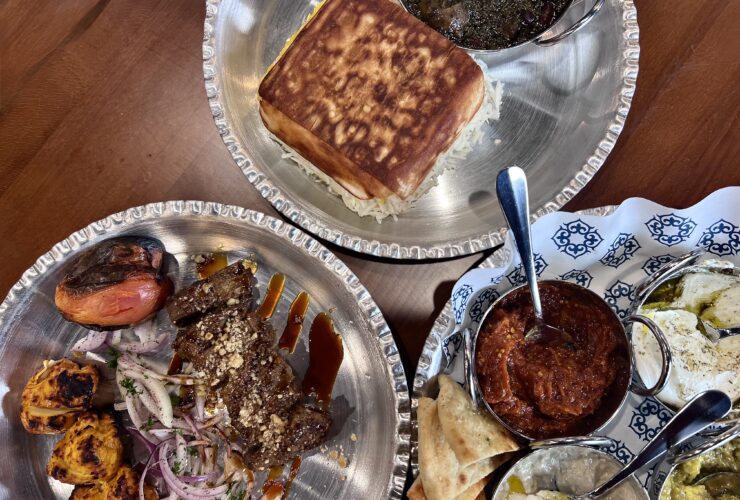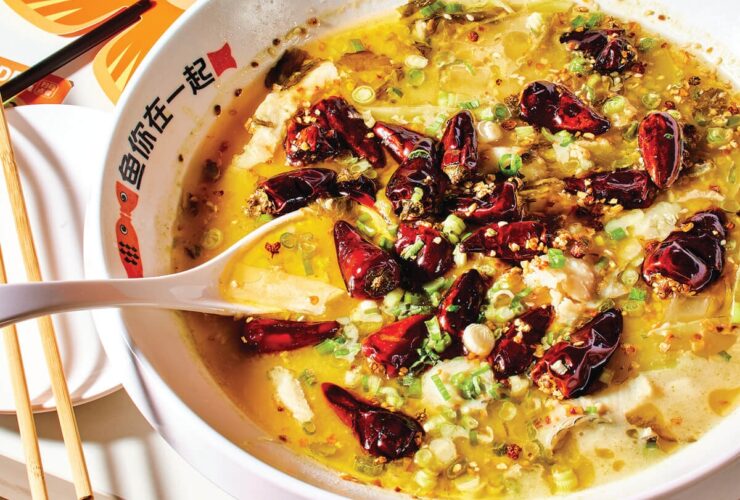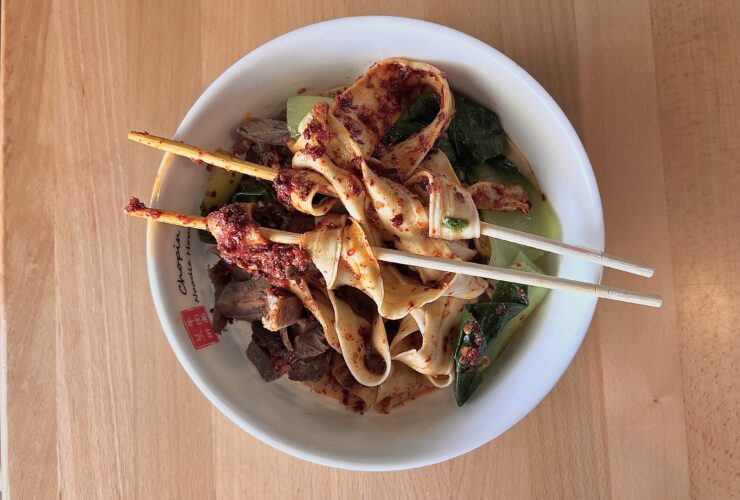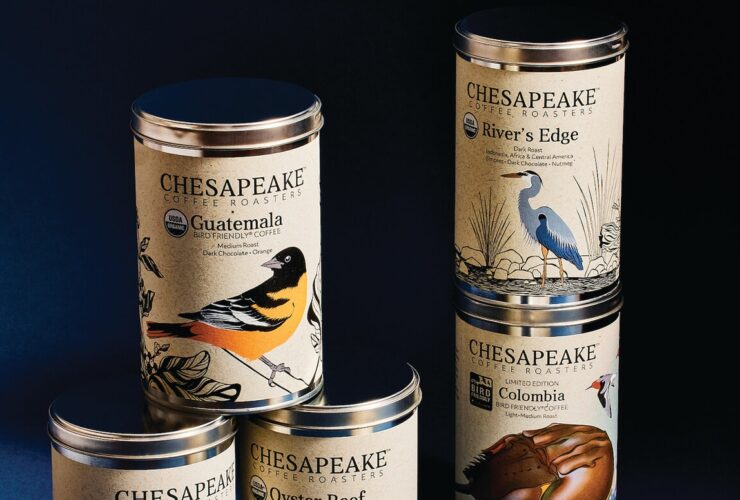
Food & Drink
Well Preserved
Canningshed’s director of preservation brings summer to your winter plate.
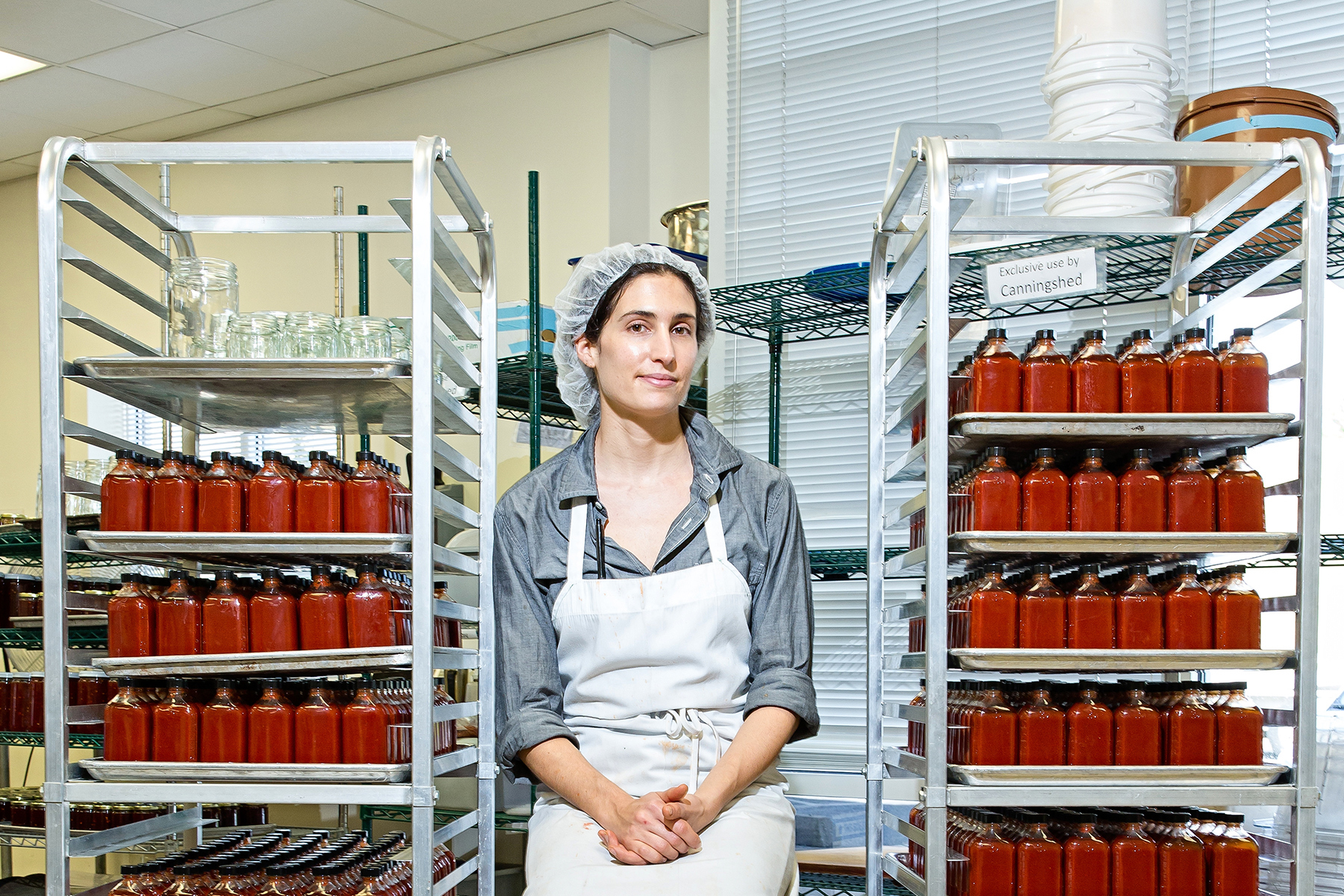
 n a brisk October morning, Lauren Sandler hustles across an empty parking lot in the far corners of Woodberry. On this small tract of land, wedged between overgrown railroad tracks and steady traffic on the Jones Falls Expressway, she makes her way inside a cinderblock building, moving through the vacant space toward a hulking freight elevator, which she slides open and heaves shut before pressing a red button. The lift lurches then lands in the depths of the cool earth, where a dank hallway leads to a dimly lit bunker, filled with sky-high stacks of Snake Oil hot sauce, towering boxes of jarred tomatoes, and teetering pallets of strawberry jam.
n a brisk October morning, Lauren Sandler hustles across an empty parking lot in the far corners of Woodberry. On this small tract of land, wedged between overgrown railroad tracks and steady traffic on the Jones Falls Expressway, she makes her way inside a cinderblock building, moving through the vacant space toward a hulking freight elevator, which she slides open and heaves shut before pressing a red button. The lift lurches then lands in the depths of the cool earth, where a dank hallway leads to a dimly lit bunker, filled with sky-high stacks of Snake Oil hot sauce, towering boxes of jarred tomatoes, and teetering pallets of strawberry jam.
This subterranean cache belongs to Canningshed—the preservation program of James Beard Award-winning chef Spike Gjerde—and, as winter looms, it will transform into a clandestine war chest, fortified to supply Gjerde’s growing brood of Baltimore restaurants with the bright flavors of warm-weather produce through the long, cold days ahead.
“I made 94,000 more jars this year,” says Sandler, looking around her well-stocked warehouse with a worried smile. “So we’ll have to find space for those in here somehow, too.”
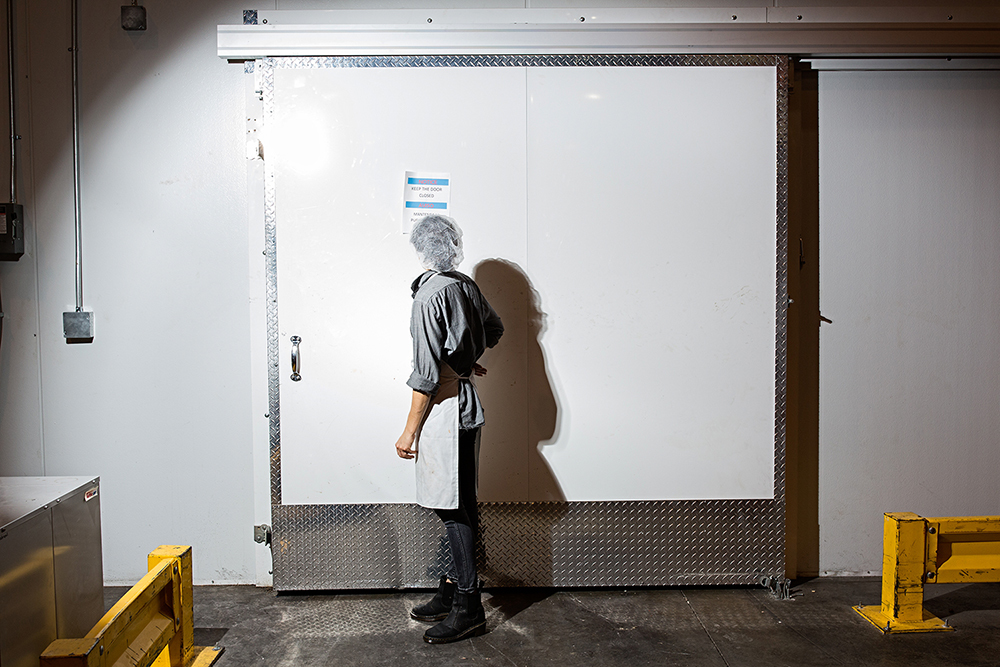


Sandler enters the storage space of the Maryland Packaging plant in Elkridge, Maryland; glass jars wait to be filled with jelly and jam; empty crates were once filled with colorful produce, now processed into preserved goods by Sandler and her few employees.
As Canningshed’s director of preservation, Sandler, 32, has made all of this almost singlehandedly—the 1,000 jars of jam, the 5,000 bottles of hot sauce, the countless quantities of preserved herbs and spices, ranging from the vibrant dried greens of lemon thyme and garlic chives to the resplendent rosy powders of blush-pink rhubarb and brick-red poblanos.
In her standard uniform of a white apron and an old pair of black Doc Martens, she spent all summer packing tomatoes, preserving berries, fermenting peppers, and juicing the likes of cherries and cantaloupes in order to bottle the season’s bounty. Much of that fruit will eventually stock store shelves as Woodberry Pantry products, while other ingredients will be worked into cocktails, sauces, and suppers at Woodberry Kitchen, Artifact Coffee, Parts & Labor, Bird in Hand, Sandlot, and now A Rake’s Progress in Washington, D.C.
After 10 years, Canningshed is nothing new for Gjerde’s decade-old food group, but since bringing Sandler on board in 2014, the operation has truly come into its own. With just a handful of employees, she is helping to sustain an ancient human tradition, as the practice of preservation—the salting, smoking, drying, dehydrating, freezing, fermenting, curing, and canning of foods—is as old as mankind itself. Those methods also have deep ties to the Chesapeake Bay, where a booming industry once studded our shorelines with canneries and packinghouses from the mid-19th through the early-20th centuries, filling tins with everything from oysters and crab to peaches and tomatoes, the latter of which Canningshed is now dipping its toes in, too.
In the grand scheme of things, Sandler is not only expanding the year-round repertoire of local restaurants, but also engaging in a larger conversation about the feasibility of this praxis—in Baltimore and beyond.
You could really say that she is what makes Woodberry Woodberry.
The practice of preservation
is as old as mankind itself.
Fish peppers are dehydrated for later use.
Born and raised in Mount Washington, Sandler grew up with an innate appreciation for the preparation of a meal. “I come from a family that talks about lunch during breakfast and dinner during lunch,” she laughs. “I was very fortunate to always have fresh food on the table. So much so that I was always the kid at school trading my [homemade] turkey sandwich for Lunchables.”
By the time she got to college at the Rhode Island School of Design, she was hosting dinner parties with her roommate and dreaming of becoming a photographer for Gourmet magazine. But after graduating in 2008, the economy had tanked, the gourmand glossy had shuttered, and she found herself restless as an employee at an art gallery in New York. “In hindsight, I think photography was the wrong thing for me anyway,” says Sandler. “I really needed something more hands on.”
After a first date at Brooklyn’s beloved Franny’s—the now-closed farm-to-table pizzeria that was on the cutting edge of the country’s locavore food movement—she applied for a job as a hostess. “It was love at first sight, or bite,” quips Sandler. “The owners had fine-dining backgrounds but they wanted to get back to the roots of food. Everything came from the farmers’ market; that was the way of cooking in Italy. There was no importing of ingredients just to make a single dish.”
She quickly moved through the ranks before landing a job in the intimate open kitchen. There, she mastered each station and educated herself on the ingredients of every dish. Many of them were pickled, like fennel and ramps, or preserved, like Meyer lemons. On her own time, Sandler also filled her tiny apartment with homemade pickles and peach preserves.
But in 2014, in a Smalltimore twist of fate, she bumped into Gjerde’s business partner, Corey Poloyka, at the wedding of her sister, who had once been a Woodberry server. Poloyka had heard about Sandler’s canning hobby and thought she might be right for an open position within their company. “I kept thinking, ‘Oh my God, I didn’t realize my dream job actually existed,’” she recalls. “That’s what I was already practicing at home, on my days off. But they took it to the next level, and I saw that as a challenge.”

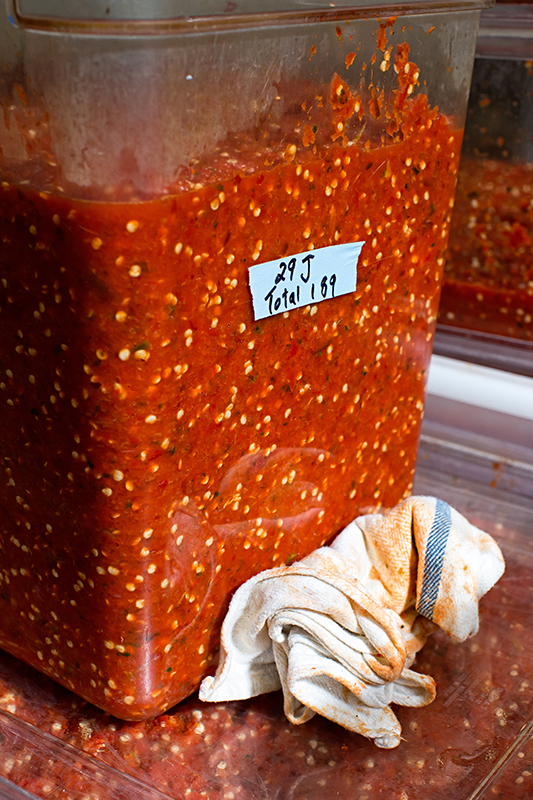
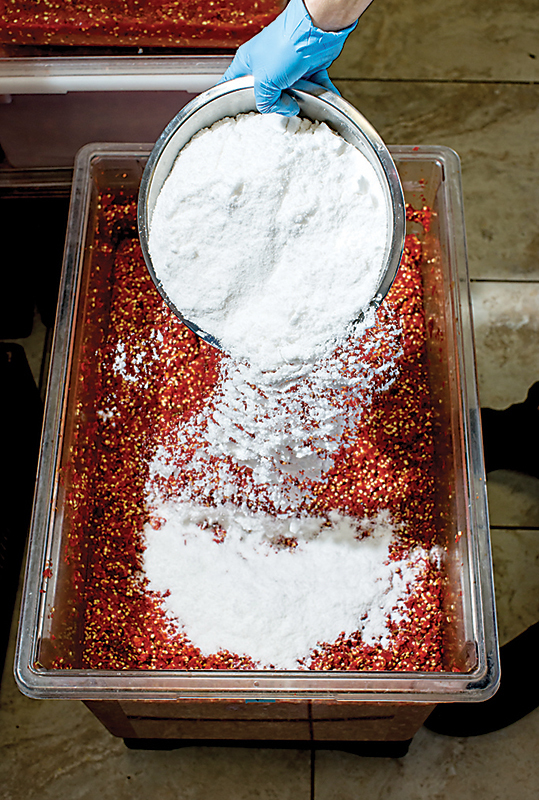

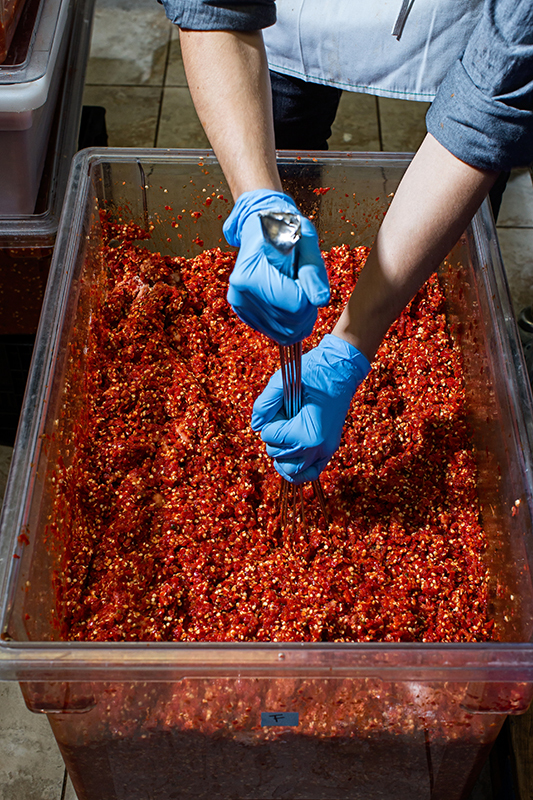
Sandler uses salt to brine the fish pepper mash that will then be moved into large barrels for fermentation.
Today, Sandler has an endless supply of challenging tasks at her weekday office—the giant Maryland Packaging plant in Elkridge that, with its bright fluorescent lights and employees in white hairnets, is a far cry from Gjerde’s hipster-chic, reclaimed-wood restaurants. Here, she crafts all of the canned goods that will later make their way to the Woodberry warehouse. In one corner of the industrial kitchen stands a tower of plastic crates filled with colorful peppers that need to be processed into tiny bottles of hot sauce. Off to the side in cold storage, she sifts through cardboard cartons of fresh-picked raspberries that must become jam before they turn to fuchsia mush.
But the willowy Sandler drifts about her daunting duties with a cool and easy grace. Her dark eyes focus on the job at hand, though she still stops to soak up the caramelized smell of cooked rhubarb. She stands in awe of the golden granules of coriander. She revels in a few sips of just-squeezed yellow watermelon juice. “There are a lot of people who work hard and fast but kind of make a show of it,” says Gjerde. “Lauren is the opposite.”
Luckily so. From her first day at Canningshed, Sandler was thrown into the fire with little more than a few half-written recipes and a handful of dated e-mails to put all of the pieces together. On top of that, she was filling every bottle and jar by hand in the shoebox kitchen of the since-shuttered Shoo-Fly in Belvedere Square, and carrying each box of finished product up a flight of stairs to a cramped storage space above the diner.
These days, as she swings through wide doorways and peeks into a giant freezer the size of a small tractor-trailer, Sandler can’t help but wax rhapsodic about the perks of her newfound digs. The commercial facility offers additional space, for starters, plus high-tech equipment like an industrial filler, a high-pressure processing machine, a refrigerated juicing room, and a fast-paced labeler that she reserves for winter work. Many of the small, beautiful labels, designed by Maryland Institute College of Art professor Mary Mashburn, are still applied by hand, but the goal is to do things as quickly, efficiently, and economically as possible.

Leftover rinds sit beside a bucket of fresh-squeezed watermelon juice.
Canningshed is now a year-round operation, and as soon as strawberries arrive in spring, Sandler is busy through the first frost. “Produce comes and goes quickly,” she says. “We won’t keep it over a weekend—it’s either in a jar, barrel, or dried by the end of the week.”
Her pace is dictated by the harvest. For two weeks straight, she can do nothing but hull strawberries, pit peaches, or blanch and peel tomatoes. At the same time, she can turn nearly 2,000 pounds of cherries into jam within 48 hours in June, or transform 300 pounds of cucumbers into pickles on the same day in July. On one Monday toward the end of August, she processed more than 2,000 pounds of tomatoes into some 200 jars before Friday. Most items then have a three-year shelf life. Otherwise they’re frozen until needed.
In addition to the natural deadlines of spoiled vegetables and rotten fruit, Sandler also has to adhere to the hefty regulations surrounding all food-processing operations from the state and FDA. She keeps a comprehensive record of every cabbage or cucumber that finds its way into her kitchen, as well as a detailed inventory of every jam or jelly that makes its way out. It’s all accounted for with a paper trail that includes dates, batch numbers, temperatures, and times for each step of the process.
“Everything we do has this crazy legal attachment to it, which kind of takes some fun out of it, but also keeps everything safe,” says Sandler. And besides, she likes the meticulous work. “Math and science were always the two things that interested me before I decided to do art. I like multitasking and organization. I love methodical techniques, and making mistakes to learn a better way.”
Under Sandler’s watch, Canningshed now has some 70 state-approved foods made from dozens of local ingredients that arrive directly from some 48 farmers to the loading dock in Elkridge. Those include all of those jams, jellies, pickles, and preserves, plus a medley of juices and a cornucopia of dried herbs, spices, fruits, and even shitake mushrooms, which she dries in a dehydrator or low-heat oven. There’s lavender and rosemary, raisins and mint leaves, onion powder and garlic. “In the wintertime,” says Sandler of the latter, “we stink up the entire place.”
There’s a lot of trial and error, and even a few outright experiments, but nothing goes to waste. “I’ve never thrown anything out,” she says. “If I have a sour cherry jam that never sat up, I’ll call our pastry chef, Rachel, to see if she could use the syrup for one of her desserts.”
What she does have down pat, though, is the fearless fish pepper, a regional heirloom variety that Gjerde essentially brought back from the dead. As of press time, Sandler has processed more than 45,000 bottles of Snake Oil, grinding hundreds of thousands of hot peppers into a thick red mash before adding it to a salt brine and storing it in Smooth Ambler whiskey barrels, where it will ferment for at least one year. After that, the remaining mash will be dried into pepper flakes or crushed into powder to replace the exotic black peppercorn, while its juices will be mixed with vinegar and water before being filled into endless racks of old-medicine-style bottles, one of which will make its way onto Sandler’s own dining room table in Towson.
“Snake Oil goes on everything,” she says. “It’s so good on eggs. It’s best on oysters. If I’ve had a long day, I add it to rice and vegetables and it will be the best thing I’ll have all week.”
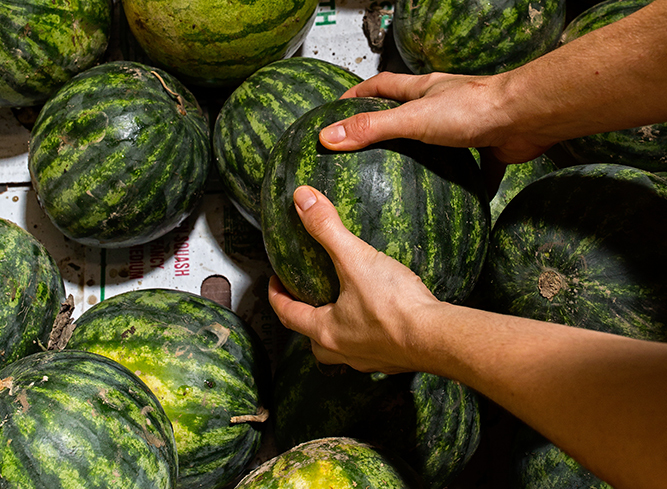

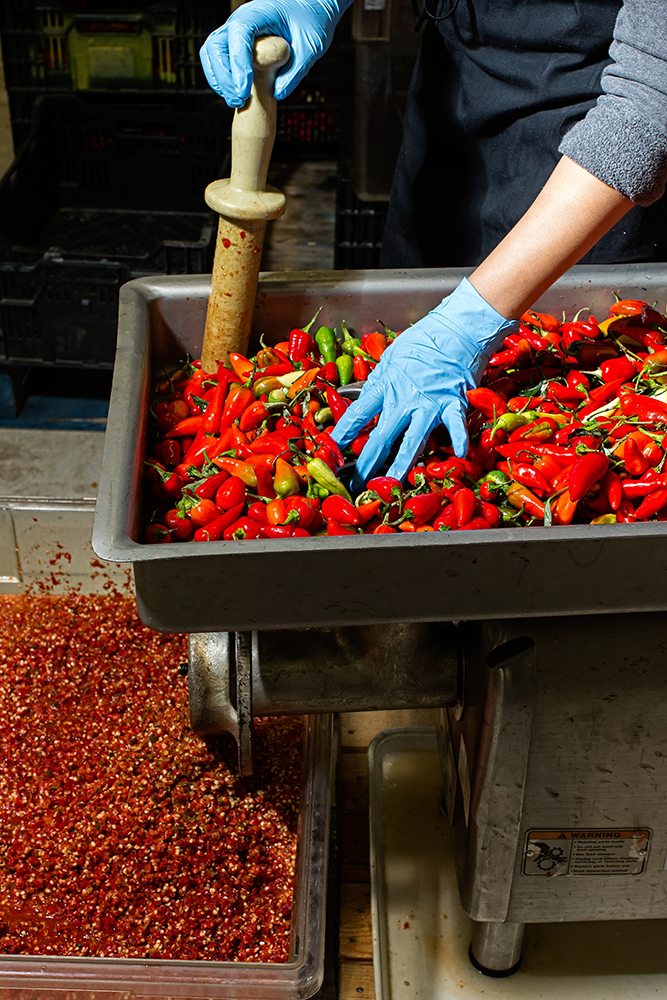
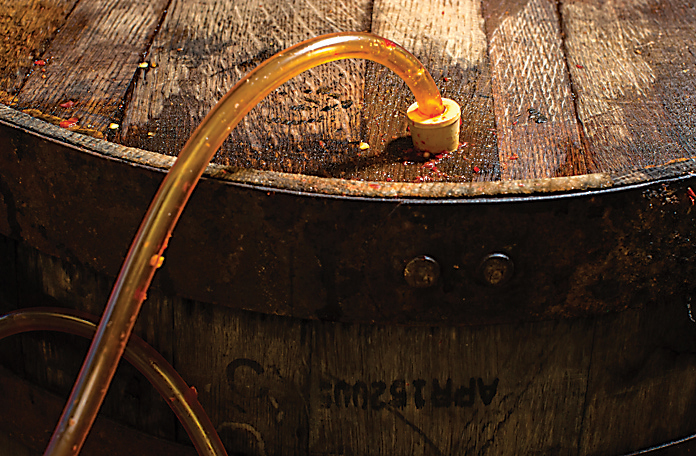
Buckets of fish peppers come in from a few go-to area farmers; the peppers are then ground into mash; the mash is brined and fermented in old Smooth Ambler whiskey barrels; after one year, it will be removed from the barrels while the leftover liquid will be bottled into Woodberry’s beloved Snake Oil hot sauce.
With all of that produce then stockpiled in proximity to Gjerde’s restaurants, the lauded chef is able to fulfill, and even surpass, his main mission of subsisting on virtually nothing but regional food. Grapes in March? Only as raisins in your scone or muffin. Blueberries in April? Only as a spread for your toast and tea. Sugar for your coffee? It’s fair trade and organic right now, but Sandler’s attempting to turn local sorghum into molasses to replace the black sheep of imported sweetener.
“Luckily, I only had to go through one winter without her, but I made the mistake of ripping through everything pretty quickly,” says chef de cuisine Opie Crooks, who started a year before Sandler. “We’re not creating dishes from cookbooks—it’s much more inspired by the moment—and having a beautiful pantry gives us a Rolodex of flavors to choose from.”
But besides bringing diners the bright juice of an August peach in the barren tundra of February, Sandler also strives to rethink the way we eat. “It’s about trying to change the food system,” she says. “There’s no reason for us to buy tomatoes from California in winter when we have the ability to jar them here and create less of a footprint. We want to keep that practice—and that conversation—going.”
Those conversations begin in January, when Sandler, Gjerde, and the rest of the chefs meet with their go-to growers to discuss the upcoming year. Sometimes, Sandler is planning two or three winters ahead, though Mother Nature always throws a few curveballs along the way. It’s been a trying year for tomatoes, and by mid-September, an entire crop of expected vegetables had yet to ripen. “I learn so much every season,” she says, “both from failures and successes.”
“These conversations are really important, and they’ve taken on new meaning as we’ve grown Canningshed,” says Gjerde. “We want to make measurable change within the food system, and we’re negotiating the terms. And maybe if we make better decisions about how food is grown around Maryland, and if we do this long enough, and well enough, then the Chesapeake Bay will be a cleaner, more viable ecosystem. It doesn’t have to be all commodity chicken, corn, and soybean.”

Sweet pepper jelly.
For that, as the sign reads behind the bar in Woodberry Kitchen, there’s “something to prove.” If this can be done in Baltimore, ruminates Gjerde, it can be done anywhere. “And if anybody’s going to figure it out, it’s going to be Lauren,” he says. “Having somebody like her on the side of this gives me a lot of confidence that it is real.”
But there’s still so much left to do.
For now, Sandler is rushing back to her Prius in the parking lot alongside the gurgle of the Jones Falls and then on to her kitchen in Elkridge. She just received an e-mail from one of her growers. This year’s summer tomatoes have finally come to fruition, and those elusive beauties have just turned from green to red.
Maybe it was a blessing in disguise that Sandler never got a gig at Gourmet. Today she artfully curates the Woodberry Pantry Instagram page, but she’s not hiding behind a camera, taking beautiful photographs of somebody else’s food. Instead, she’s making her own.
“I love what we do here every day,” she says. “And once everything is said and done, it all goes up on the shelves in the hallway at Woodberry, and I go down there and look at all of the finished goods. To me, food and art are the same thing.”
